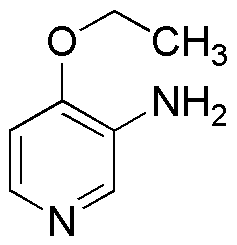4-Ethoxy-3-aminopyridine is widely utilized in research focused on:
- Pharmaceutical Development: This compound is a key intermediate in the synthesis of various pharmaceuticals, particularly those targeting neurological disorders, due to its ability to modulate neurotransmitter activity.
- Biochemical Research: It serves as a valuable tool for researchers studying enzyme inhibition and protein interactions, helping to elucidate complex biochemical pathways.
- Agricultural Chemistry: The compound is explored for its potential as a pesticide or herbicide, offering a more targeted approach to pest management while minimizing environmental impact.
- Material Science: It is used in the development of novel materials, particularly in the creation of conductive polymers, which have applications in electronics and sensors.
- Analytical Chemistry: 4-Ethoxy-3-aminopyridine is employed as a reagent in various analytical techniques, aiding in the detection and quantification of other chemical substances.
General Information
Properties
Safety and Regulations
Applications
4-Ethoxy-3-aminopyridine is widely utilized in research focused on:
- Pharmaceutical Development: This compound is a key intermediate in the synthesis of various pharmaceuticals, particularly those targeting neurological disorders, due to its ability to modulate neurotransmitter activity.
- Biochemical Research: It serves as a valuable tool for researchers studying enzyme inhibition and protein interactions, helping to elucidate complex biochemical pathways.
- Agricultural Chemistry: The compound is explored for its potential as a pesticide or herbicide, offering a more targeted approach to pest management while minimizing environmental impact.
- Material Science: It is used in the development of novel materials, particularly in the creation of conductive polymers, which have applications in electronics and sensors.
- Analytical Chemistry: 4-Ethoxy-3-aminopyridine is employed as a reagent in various analytical techniques, aiding in the detection and quantification of other chemical substances.
Documents
Safety Data Sheets (SDS)
The SDS provides comprehensive safety information on handling, storage, and disposal of the product.
Product Specification (PS)
The PS provides a comprehensive breakdown of the product’s properties, including chemical composition, physical state, purity, and storage requirements. It also details acceptable quality ranges and the product's intended applications.
Certificates of Analysis (COA)
Search for Certificates of Analysis (COA) by entering the products Lot Number. Lot and Batch Numbers can be found on a product’s label following the words ‘Lot’ or ‘Batch’.
*Catalog Number
*Lot Number
Certificates Of Origin (COO)
This COO confirms the country where the product was manufactured, and also details the materials and components used in it and whether it is derived from natural, synthetic, or other specific sources. This certificate may be required for customs, trade, and regulatory compliance.
*Catalog Number
*Lot Number
Safety Data Sheets (SDS)
The SDS provides comprehensive safety information on handling, storage, and disposal of the product.
DownloadProduct Specification (PS)
The PS provides a comprehensive breakdown of the product’s properties, including chemical composition, physical state, purity, and storage requirements. It also details acceptable quality ranges and the product's intended applications.
DownloadCertificates of Analysis (COA)
Search for Certificates of Analysis (COA) by entering the products Lot Number. Lot and Batch Numbers can be found on a product’s label following the words ‘Lot’ or ‘Batch’.
*Catalog Number
*Lot Number
Certificates Of Origin (COO)
This COO confirms the country where the product was manufactured, and also details the materials and components used in it and whether it is derived from natural, synthetic, or other specific sources. This certificate may be required for customs, trade, and regulatory compliance.


